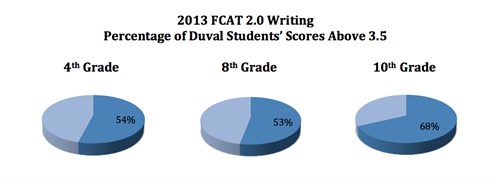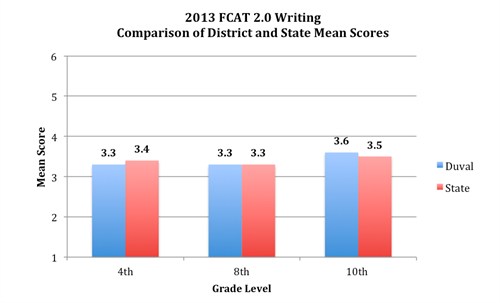Preparing students for FCAT 2.0 Writing
2/3/2014
FCAT 2.0 Writing Overview
The FCAT 2.0 Writing is a Florida writing assessment administered in grades 4, 8 and 10. This year students statewide will take the FCAT 2.0 Writing, or FCAT Writes as it is often called, on February 25 and 26. The purpose of the assessment is to measure a student's writing proficiency based on his or her ability to write on an assigned topic during a specific testing period of 60 minutes.
Deeper Look Into FCAT 2.0 Writing by Grade Level
Although the testing format, scoring, and the 60-minute time period are consistent across the grade levels, there are different types of assigned topics, known as prompts.
Possible Types of Prompt by Grade Level:
4th grade: Narrative or expository
8th grade: Expository or persuasive
10th grade: Expository or persuasive
Examples of previous year's writing prompts can be found online on the Florida Department of Education's website here.
Understanding Scoring of the FCAT 2.0 Writing
The FCAT 2.0 Writing is scored on a scale from 1 to 6, with 6 as the highest possible score. Although there is no "passing" score for FCAT 2.0 Writing, the percentage of students who score above a 3.5 is used as a component when calculating school grades. For more information on the writing score component of school grades, please click here.
 The scoring of the writing assessment is holistic, which means that the student's entire written response is evaluated based on pre-defined criteria. In the case of the FCAT 2.0 Writing, the response is scored using rubrics that address four key elements: focus, organization, support and conventions. It is important to note that in recent years scorers have focused more attention to the correct use of English conventions and the quality of supporting details than in the past when the scoring of these components was more lenient.
The scoring of the writing assessment is holistic, which means that the student's entire written response is evaluated based on pre-defined criteria. In the case of the FCAT 2.0 Writing, the response is scored using rubrics that address four key elements: focus, organization, support and conventions. It is important to note that in recent years scorers have focused more attention to the correct use of English conventions and the quality of supporting details than in the past when the scoring of these components was more lenient.
To provide further detail on the expectations of the FCAT 2.0 Writing scoring rubrics, key phrases to describe the four elements are included below.
FCAT 2.0 Writing Rubric Elements
Focus:
- Establish a main idea or theme
- Maintain a clear and consistent focus in response
Organization
- Establish beginning, middle, and end
- Use transition words and phrases
- Ensure logical progression of ideas
Support
- Use quality details (specific, relevant, and substantial support)
- Carefully choose words to "show" not just "tell"
Conventions
- Include proper punctuation
- Demonstrate correct use of capitalization
- Vary sentence structure
The actual scoring rubrics used by the scorers of the FCAT 2.0 Writing can be found on the Florida Department of Education's website here.
The graph below shows how the average scores of Duval County students in 4th, 8th, and 10th grade compare to the average scores of students across the entire state on the 2013 FCAT 2.0 Writing assessment.

Tips for Parents with Children Taking the FCAT 2.0 Writing:
Encourage Your Child to Write:
- Create opportunities for you and your child to write together in your home, i.e., writing grocery lists, writing letters to distant family members, or journaling about a recent trip or experience.
- Try to make writing fun for your child by providing creative or alternative writing materials to notebook paper and a pencil (i.e., dry erase board, novelty erasers, colored pencils or gel pens)
Familiarize Yourself with FCAT 2.0 Writing:
- Explore the sample writing prompts and rubrics used by scorers available through the Florida Department of Education website
- Review the expectations for a high score on the test and discuss this with your child (Frequently Asked Questions by the Florida Department of Education)
Day Before the Test:
- Prepare a healthy dinner and help your child to relax about the test, reminding them of their extensive practice both at home and school.
- Help to make sure your child gets a good night's rest.
Day of the Test:
- Prepare a healthy breakfast and ensure your child arrives to school on time the morning of the test.
- Remind your student to relax and simply do his or her best.
-- Kelly Turner